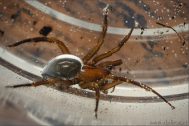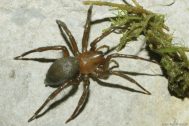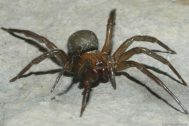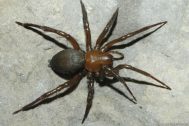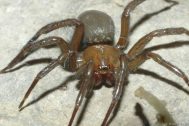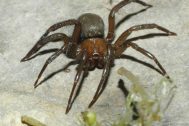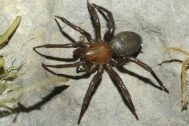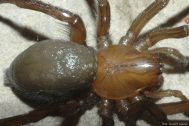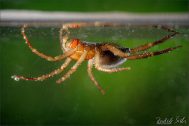| Nálezy podle období | |||||
|---|---|---|---|---|---|
| Dictynidae | 0-1900 | 1901-1950 | 1951-2000 | 2001+ | ∑ |
| Argyroneta aquatica (Clerck, 1757) Ohrožený | 6× | 4× | 63× | 47× | 120× |
Argyroneta aquatica (Clerck, 1757)
| České jméno | vodouch stříbřitý |
|---|---|
| Stupeň ohrožení | Ohrožený |
| Nálezy | 120 nálezů, 60 kvadrátů |
| První nález |
1859, F. Prach, Prach 1866 |
| Poslední nález | 2019 |
| Areál rozšíření | Palaearctic - Transp., eM |
| Fytogeografická oblast |
|
| Původnost stanovišť |
|
| Vlhkost stanovišť | - |
| Stratum | - |
| Osvětlení stanovišť |
|
| Hojnost výskytu |
|
| Nadm. výška | 150-1100 |
Literatura
Spider conservation in Europe: a review
Despite their ecological importance and diversity, spiders (Arachnida: Araneae) are underrepresented in conservation policies in comparison to other groups. We review all extant conservation tools focusing on spiders in Europe, highlighting general patterns, limitations, gaps, and future directions. We assembled a comprehensive online database reporting all available information concerning the legal protection and conservation status of 4,154 spider species. Existing international legislation has limited coverage, with only one species listed in the Bern Convention and EU Habitats Directive. At the national and subnational levels, 178 species are formally mentioned in the legislation of 19 European countries. Moreover, the International Union for Conservation of Nature (IUCN) includes assessments for 301 species worldwide, 164 of these threatened and eight native to Europe. In addition, spiders are mentioned in Regional Red Lists and Red Books in 28 out of 42 European countries considered in this review. Northern and Central European countries have the highest percentage of species assessed at the regional level in Red Lists and Red Books. The Mediterranean basin has the highest spider diversities in Europe but conservation efforts are lacking, both in terms of assessments and national or subnational legislation. Among European species, Dolomedes plantarius, Argyroneta aquatica and Eresus kollari are the most frequently mentioned in European conservation measures, possibly due to their ecological traits and their strict association with declining habitats. Considering the current threats to spiders in Europe, the protection of large areas of suitable habitat should be considered as the most effective approach to spider conservation.Pavouci a sekáči (Arachnida: Araneae, Opiliones) Klánovického lesa a jeho okolí v Praze.
The studied locality, i.e. Klánovický les Forest is situated on the edge of Prague, one of the most polluted areas in the Czech Republic. Thanks to large area the forest acts as an isolation from agrochemicals, thus allowing the existence of some habitats sensitive to eutrophisation, in particular peat-bogs, heaths, bare sandy soils, and Molinia meadows. The habitats harbour unusually high species diversity of spiders and harvestmen: the author recorded 286 spider and 11 harvestman species there, which is approximately one third of the Czech fauna. Sixty one of them are red-listed in the Czech Republic. Peat-bog linyphiid Saaristoa abnormis, and steppe lycosid Alopecosa schmidti and linyphiid Panamomops inconspicuus are listed as endangered. Local small peat-bogs offer suitable conditions for disappearing lycosids Hygrolycosa rubrofasciata, Pirata piscatorius and Piratula uliginosa, while heaths harbour the disappearing Oxyopes ramosus. Water spider Argyroneta aquatica has recently been found in small pools in ditches along the railway. Littoral vegetation is inhabited by Theridiosoma gemmosum and the jumping spider Calositticus floricola. Disturbed soil surface of wet meadows harbours the wolf spider Arctosa leopardus. Some species have recently appeared at the site, for example Dysdera hungarica, the harvestman Nemastoma bidentatum sparsum or the crab spider Synema globosum. The first two were probably introduced there by man, the latter probably expands due to climate change. The author suggests to keep these habitats without woody vegetation to protect local high species diversity there.Conservation of a pH-sensitive structure in the C-terminal region of spider silk extends across the entire silk gene family.
Spiders produce multiple silks with different physical properties that allow them to occupy a diverse range of ecological niches, including the underwater environment. Despite this functional diversity, past molecular analyses show a high degree of amino acid sequence similarity between C-terminal regions of silk genes that appear to be independent of the physical properties of the resulting silks. Instead, this domain is crucial to the formation of silk fibers. Here, we present an analysis of the C-terminal domain of all known types of spider silk and include silk sequences from the spider Argyroneta aquatica, which spins the majority of its silk underwater. Our work indicates that spiders have retained a highly conserved mechanism of silk assembly, despite the extraordinary diversification of species, silk types and applications of silk over 350 million years. Sequence analysis of the silk C-terminal domain across the entire gene family shows the conservation of two uncommon amino acids that are implicated in the formation of a salt bridge, a functional bond essential to protein assembly. This conservation extends to the novel sequences isolated from Argyroneta aquatica. This finding is relevant to research regarding the artificial synthesis of spider silk, suggesting that synthesis of all silk types will be possible using a single process.
Fotografie
Statistiky
Dle měsíce v roce
Dle nadmořské výšky
Dle metody sběru (120 použitých nálezů)
| Argyroneta aquatica (Clerck, 1757) VU | Samci | Samice | Mláďata | Nálezy |
|---|---|---|---|---|
| Neurčeno | 2 | 4 | 1 | 85 |
| Individuální sběr | 37 | 44 | 22 | 23 |
| Fotografie | 0 | 1 | 0 | 1 |
| Prosev | 1 | 0 | 1 | 2 |
| Zemní past | 16 | 17 | 3 | 8 |
| Smyk | 1 | 0 | 0 | 1 |
| Samci | Samice | Mláďata | Nálezy |
Dle biotopu (120 použitých nálezů)
| Argyroneta aquatica (Clerck, 1757) VU | Samci | Samice | Mláďata | Nálezy |
|---|---|---|---|---|
| Neurčeno | 40 | 41 | 6 | 92 |
| Rákosiny a orobincové porosty stojatých vod | 2 | 3 | 0 | 7 |
| Stojaté a pomalu tekoucí vody | 1 | 4 | 8 | 10 |
| Rašeliniště | 1 | 0 | 1 | 2 |
| Rostlinstvo vodní hladiny | 1 | 0 | 12 | 3 |
| Močály | 11 | 15 | 0 | 3 |
| Ostřicové porosty stojatých vod | 0 | 2 | 0 | 1 |
| Zahradnicky utvářené zahrady a parky | 1 | 1 | 0 | 2 |
| Samci | Samice | Mláďata | Nálezy |





